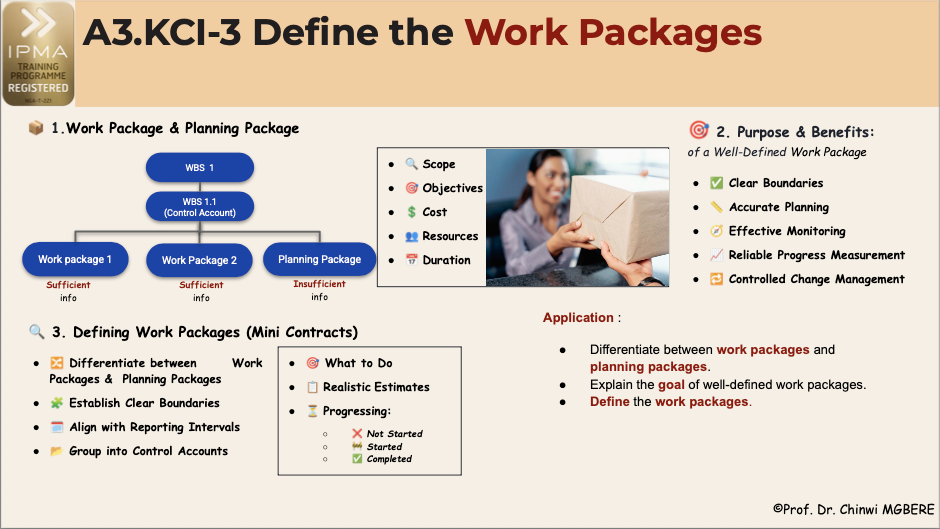- Differentiate between work packages and planning packages.
- Explain the goal of well-defined work packages.
- Describe the work packages.
2 CPD Hours.

A3.KCI-3: Define the Work Packages of the project
1. Work and planning packages
A work package is the lowest-level deliverable in the Work Breakdown Structure (WBS). It represents a clearly defined, measurable scope of work that can be easily assigned, estimated, executed, and tracked
It contains all the necessary details for execution and control, including:
- Scope – What work is to be performed
- Objectives – The outcome or purpose of the work
- Cost – Budget estimate for the work
- Resources – Human and material resources needed
- Duration – Time required to complete the work
If some of these details are not yet defined (e.g., duration, cost, or resources), the element is called a planning package instead of a work package. A planning package is a placeholder for future detailed planning.
In agile projects, particularly in software development, a work package may correspond to a user story, where similar principles of clear definition and deliverability apply.
2. Purpose and Benefits of Well-Defined Work Packages
Clear, complete work packages provide the foundation for effective planning, execution, and control. Benefits include:
- Clear boundaries for scope
- Accurate Planning – Easier estimation of time, cost, and resources
- Effective Monitoring – Tracking status and completion more precisely
- Reliable Progress Measurement – Observable and provable progress
- Controlled Change Management – Traceable Scope, schedule, and budget
For Example: In a construction project, “Install Kitchen Cabinets” could be a work package, with a defined budget, 3-day duration, 2 carpenters assigned, and a specific scope including type, layout, and fittings.
3. Defining Work Packages
To define work packages effectively:
- Differentiate between Work Packages & Planning Packages
- A Work Package is fully defined (with scope, cost, duration, resources)
- A Planning Package is a High-level scope; Here, detailed planning is deferred
- Establish Clear Boundaries
- Avoid overlap with other work packages
- Ensure every package is traceable to a deliverable
- Align with Reporting Intervals
- Break down work so that each package fits within the reporting cycle (e.g., biweekly).
- Group into Control Accounts: Group related work packages under control accounts for tracking and reporting purposes. Each control account acts as a summary level for:
- Budget tracking
- Schedule updates
- Resource management
A work package must be defined in such detail that:
- The team can understand exactly what to do
- Realistic estimates for effort, time, and cost can be made
- Progress can be tracked at regular intervals (e.g., every 2 weeks)
By defining work packages with roughly a two-week duration, their status can always be clearly categorized as:
Status: Not Started / Description: No work has begun
Status Started / Description: Began during the current reporting period
Status: Completed / Description: Finished within the current reporting period
Status: Archived (Completed Previously) / Description: Completed in a previous reporting period
This structure helps avoid vague progress statuses, such as “25% done” and instead provides objective evidence of completion. It also reduces the risk of optimistic bias in reporting.
For Example, in a digital marketing campaign, a work package like “Launch Email Campaign #2” should be fully completed within a 2-week sprint. Status at any time is binary – either done or not done.
To apply these actions to your current initiative, follow these steps:
- Clearly distinguish between Work Packages and Planning Packages to ensure effective planning. It helps your team understand which tasks are ready for execution and which ones still require further development and definition. For Example (in a Construction Project):
- The Work Package: “Install electrical wiring in ground floor” – has blueprint, team, 3-day estimate, and $5,000 budget.
- The Planning Package: “Fit-out of upper floors” would be defined only in scope, pending final architectural details.
- Clarify the Purpose and Benefits of Well-Defined Work Packages. This promotes transparency, accountability, and performance tracking. It also reduces ambiguity and aligns the team with clear expectations.
- Define Each Work Package like a mini contract, whereby everyone understands what’s to be done, how long it will take, and with what resources, making execution smoother and easier to control. Relevant Attributes include:
- Scope Description
- Deliverables – Tangible outputs
- Start and End Dates
- Estimated Duration
- Resources Assigned
- Estimated Cost
- Dependencies/Constraints


